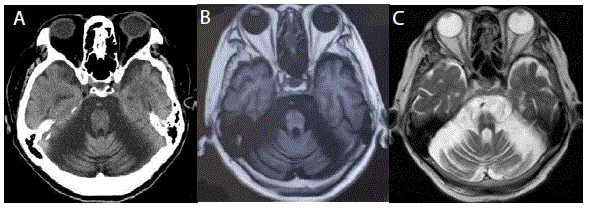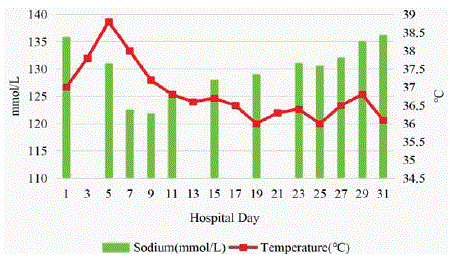
Case Report
Austin J Neurol Disord Epilepsy. 2022; 8(1): 1050.
Multiple System Atrophy with Syndrome of Inappropriate Antidiuretic Hormone
Yu DD¹, Wang W² and Tang W¹*
¹Department of Neurology, Affiliated Hospital Xinhua Hospital, Dalian University, Dalian, China
²Department of Rehabilitation, Affiliated Hospital Zhongshan Hospital, Dalian University, Dalian, China
*Corresponding author: Tang W, Department of Neurology, Affiliated Hospital Xinhua Hospital, Dalian University, 156 Wansui St, Dalian, China
Received: September 30, 2022; Accepted: October 26, 2022; Published: November 02, 2022
Abstract
Multiple System Atrophy (MSA) is a rare neurodegenerative disease which mainly affects extrapyramidal system, cerebellum and autonomic nervous system as well as hypothalamus. Hypothalamic disturbances can lead to the Syndrome of Inappropriate Antidiuretic Hormone (SIADH) and resultant hyponatremia. MSA with SIADH is rarely reported. We reported a 71-year-old woman was admitted to our hospital because of fever for two months. She was diagnosed with probable multiple system atrophy based on poorly L-Dopa responsive parkinsonism, urinary incontinence and orthostatic hypotension. Hyponatremia, and the urine sodium and osmolality increased indicating that she had SIADH at the same time. Hyponatremia was corrected after water restriction and sodium supplementation. In this report, we describe the clinical characteristics and treatment in regard to MSA with SIADH.
Keywords: Multiple System Atrophy; Syndrome of Inappropriate Antidiuretic Hormone; Hyponatremia; Antidiuretic Hormone
Introduction
Multiple System Atrophy (MSA) is a neurodegenerative disease with rapid progression and poor prognosis [1]. Pathologically, there is widespread presence of Oligodendroglial Cytoplasmic Inclusions (GCI) composed of a synuclein within the central nervous system [2]. According to the cardinal clinical motor symptoms [3], MSA can be divided into two subtypes: MSA parkinsonian type (MSA-P) and MSA cerebellar type (MSA-C). The main manifestation of MSA-P is rigidity and bradykinesia, while MSA-C is characterized by unstable gait and ataxia. Autonomic dysfunction and Non Motor Symptoms (NMS) can be seen in both two types, and may precede the typical motor symptoms [4]. Syndrome of Inappropriate Antidiuretic Hormone Secretion (SIADH) [5] is a disorder defined by excess release of Antidiuretic Hormone (ADH), resulting in increased water retention. Common causes include pulmonary diseases, tumors, inflammation, central nervous system diseases, drugs or surgery [6]. Patients with MSA are at risk for SIADH. Research shows that MSA can affect the hypothalamus and its connecting fibers, cause hypersensitivity of antidiuretic hormone neurons in the hypothalamus, increase the secretion of antidiuretic hormone, and cause SIADH and hyponatremia [7].
Case Presentation
A 71-year-old woman was admitted to our hospital complaining of fever for two months. The result of COVID-19 nucleic acid test was negative. CT scan of chest showed bronchitis. Urinalysis showed white blood cell: 463.40 /μl and klebsiella pneumoniae was cultured in urine. Her temperature droped after anti infective treatment. Six years ago, she started manifesting with frequent urination, nocturia, constipation, unstable walking, bradykinesia and shouting at night. She was diagnosed as cerebellar atrophy four years ago and did not improve after symptomatic treatment. Walking instability gradually worsened and she had laryngeal stridor all day for two years. One year ago, she cannot hold the bowel, and had urinary incontinence. Two months ago, she was in bed with fever, dysphagia, barylalia and no sweat. On clinical examination, irregular breathing rhythm, laryngeal stridor, BP: 95/66mmHg (supine position), 114/53mmHg (sitting position). The breathing sound of both lungs was thick, and there were no scatte red dry and wet rales in both lungs. She was conscious but cannot cooperate with all neurological examination. Bilateral pulils were equal in size at 3.0 mm, which were sensitive to the light. The muscle strength was at grade and hypomyotonia. The muscle tension was weakened. Bilateral Babinski signs were positive. Cranial CT showed the obvious atrophy of brainstem and cerebellum, and T2-Weighted Image (T2WI) demonstrated the Hot-Cross-Bun Sign (HCB) in pons. MRI of pituitary was normal (Figure 1). According to the diagnostic criteria [8], she was diagnosed as probable multiple system atrophy.

Figure 1: CT (A) showing the volume of cerebellum and brainstem decreased significantly and the sulcus deepened. MRI (T1WI: B; T2WI: C) revealed the atrophy
of cerebellum and the hot-cross-bun sign (HCB) on pons.
Hematological examination showed normal serum sodium levels of 135.8 mmol/L on admission. However, serum sodium levels decreased to 121.0 mmol/L on the 7th day of the hospitalization. Plasma osmotic pressure was 259.11 mOsm/kg (280-310 mOsm/kg), urine osmolarity was 974 mOsm/kg (600-1000 mOsm/kg), and urine sodium was 460 mmol/24h (130-260mmol/24h). Thyroid, renal, and adrenal functions were normal. She was diagnosed as SIADH based on the diagnostic criteria of Bartter and Schwartz [9]. Her sodium was slowly corrected with hypertonic saline and she was also placed on fluid restriction, less than 2 L per day. Her serum sodium started to improve and became to narmal by the 29th hospitalization day (Table 1). According to the sensitive test of bacteria, she received the combination therapy of cefoperazone/sulbactam sodium and moxifloxacin, and her temperature returned to normal after 11 days of treatment (Table 1). At discharge, she could simply communicate with her family, but was still in bed.

Table 1: Changes of temperature and sodium during hospitalization.
Discussion
Syndrome of Inappropriate Antidiuretic Hormone (SIADH) [5] is characterized by excessive release of antidiuretic hormone without kidney or endocrine disorder, which leads to obstruction of free water discharge. SIADH is the most common cause of clinical hyponatremia, and the causes of it are variable, such as tumor, pulmonary disease, central nervous system diseases, or drugs. Water restriction is the first-line recommended therapy in the current guidelines. Multiple System Atrophy (MSA) [1] is a fatal neurodegenerative disease which pathologically affects putamen, substantianigra, pons, inferior olivary nucleus, cerebellum and intermediolateral cell columns of spinal cord. MSA mainly manifests with motor symptoms and Non Motor Symptoms (NMS) [3]. Motor symptoms are more common in MSA-P, which should be differentiated from Parkinson’ Disease (PD). The incidence of NMS in the whole course of MSA is about 74%, which often occurs many years before motor symptoms, and may even be the only symptom, which seriously affects the prognosis [10]. NMS includes autonomic dysfunction, sleep disorders, cognitive impairment and psycho affective disorders [11]. Hyponatremia caused by MSA complicated with SIADH has been rarely reported (Table 2). Nagumo et al., [12] firstly reported the Shy-Drager syndrome with SIADH. Our patient had no evidence of tumor and PET-CT showed no abnormalities. No drugs related to SIADH were taken outside the hospital or during hospitalization, and no central nervous system diseases were observed. She had bronchitis on admission, but SIADH appeared on the 5th hospitalization day when the bronchitis had been better. So we speculated that pulmonary infection may be the predisposing factor for SIADH in MSA. The pathogenesis of MSA with SIADH remains unclear. There is no specific treatment for MSA, so the main treatment for MSA with SIADH is to remove the inducement and maintain the balance of water and sodium. Current treatments for SIADH include fluid restriction, intravenous salt solutions, oral sodium supplements, and oral vasopressin receptor antiseptics (tolvaptan) [5].
Case
Age
(year)/sexDiagnosis
Serum
Sodium
(mmol/L)Serum
Osmolality
(mOsm/kg H2O)Urine
osmolarity (mOsm/kg H2O)Urine
Sodium
(mmol/L)Concomitant disease
Nagumo K
et al [12]52/M
MSA-P
127
262
319
—
None
61/F
MSA-C
99
205
474
—
Pneumonia
52/M
MSA-P
127
262
319
—
—
67/M
MSA-P
124
255
420
—
Cardiac pacemaker
SamukawaM et al [7]
52/M
MSA-C
120
246
381
—
Fever
76/M
MSA-P
118
244
304
—
—
62/F
MSA-C
118
254
—
—
Apnea
58/F
MSA-P
116
—
722
—
Nephropyelitis
Xie MQ et
al[13]62/M
MSA-P
123
280
457
91
Pneumonia
59/M
MSA-C
118
—
—
114
Pneumonia
53/M
MSA-P
121
—
—
129
None
Su TT et al[14]
53/M
MSA-C
122
257.89
945.34
209
Pneumonia
Qiu JM et al[15]
58/M
MSA-P
113.1
243.2
—
307.2
Pneumonia
Table 2: Reported cases of MSA with SIADH.
In conclusion, MSA with SIADH is rare, but attention should be paid to the water-sodium balance in patients with MSA. The management of water and sodium balance should be strengthened for MSA, especially those with pulmonary infection.
References
- Fanciulli A, Stankovic I, Krismer F, Seppi K, Levin J, et al. Multiple system atrophy. Int Rev Neurobiol. 2019; 149: 137-192.
- Koga S, Dickson DW. Recent advances in neuropathology, biomarkers and therapeutic approach of multiple system atrophy. J Neurol Neurosurg Psychiatry. 2018; 89: 175-184.
- Jung YJ, Kim HJ, Yoo D, Choi JH, Im JH, et al. Various Motor and Non-Motor Symptoms in Early Multiple System Atrophy. Neurodegener Dis. 2019; 19: 238-243.
- Gilman S, Wenning GK, Low PA, Brooks DJ, Mathias CJ, et al. Second consensus statement on the diagnosis of multiple system atrophy. Neurology. 2008; 71: 670-676.
- Poch E, Molina A, Piñeiro G. Syndrome of inappropriate antidiuretic hormone secretion. Med Clin (Barc). 2022; 159: 139-146.
- Jones DP. Syndrome of Inappropriate Secretion of Antidiuretic Hormone and Hyponatremia. Pediatr Rev. 2018; 39: 27-35.
- Samukawa M, Hirano M, Sakamoto H, Kitada M, Kusunoki S, et al. Risks of inappropriate secretion of antidiuretic hormone in multiple system atrophy. Mov Disord. 2011; 26: 2572-2573.
- Meissner WG, Fernagut PO, Dehay B, Péran P, Traon AP, Foubert-Samier A, et al. Multiple System Atrophy: Recent Developments and Future Perspectives. Mov Disord. 2019; 34:1629-1642.
- Bartter FC, Schwartz WB. The syndrome of inappropriate secretion of antidiuretic hormone. Am J Med. 1967; 42: 790-806.
- Köllensperger M, Geser F, Ndayisaba JP, Boesch S, Seppi K, et al. Presentation, diagnosis, and management of multiple system atrophy in Europe: final analysis of the European multiple system atrophy registry. Mov Disord. 2010; 25: 2604-2612.
- Zhang L, Cao B, Ou R, Wei QQ, Zhao B, et al. Non-motor symptoms and the quality of life in multiple system atrophy with different subtypes. Parkinsonism Relat Disord. 2017; 35: 63-68.
- Nagumo K, Kita K, Kitano K, Simoe Y, Furumoto H. [Shy-Drager syndrome and the syndrome of inappropriate secretion of antidiuretic hormone]. Rinsho Shinkeigaku. 1992; 32:177-181.
- Xie MQ, Zhang Y, Wang H, Cui LY. Multiple system atrophy with syndrome of inappropriate antidiuretic hormone secrection: clinical analysis on three cases. Chin J contemp neurol neurosurg. 2017; 17: 133-137.
- Su TT, Liu J, Gao L, Guo H, She BY, Qiang W. One case of multiple system atrophy with the syndrome of inappropriate antidiuresis. Chin J Endocrinol Metab. 2019; 35: 511-514.
- Qiu JM, Shen HX, Wang DF. Multiple system atrophy complicated with sydrome if inappropriate antidiuresis: a case report and literature review. Clinical Focus. 2022; 37: 451-454.